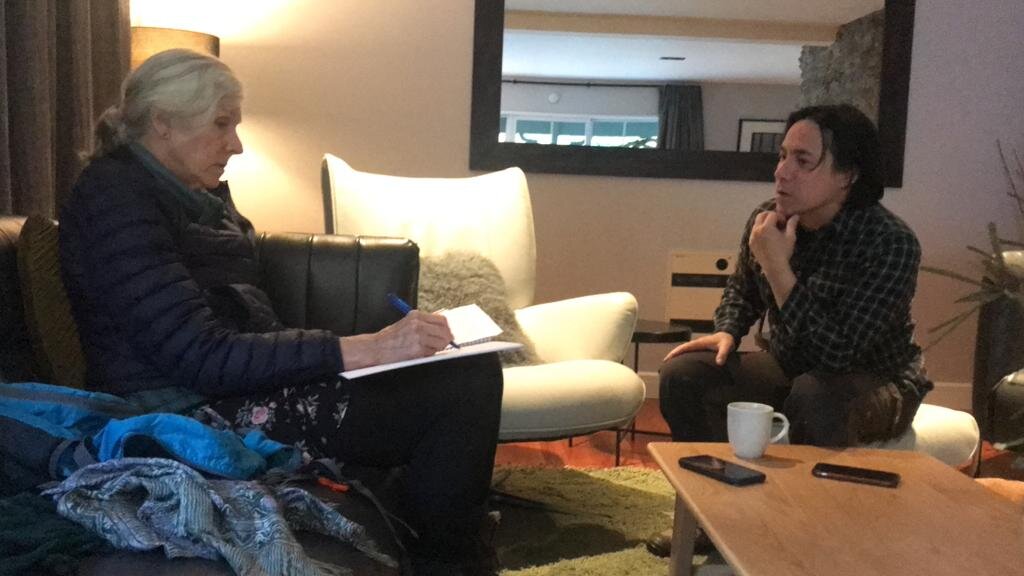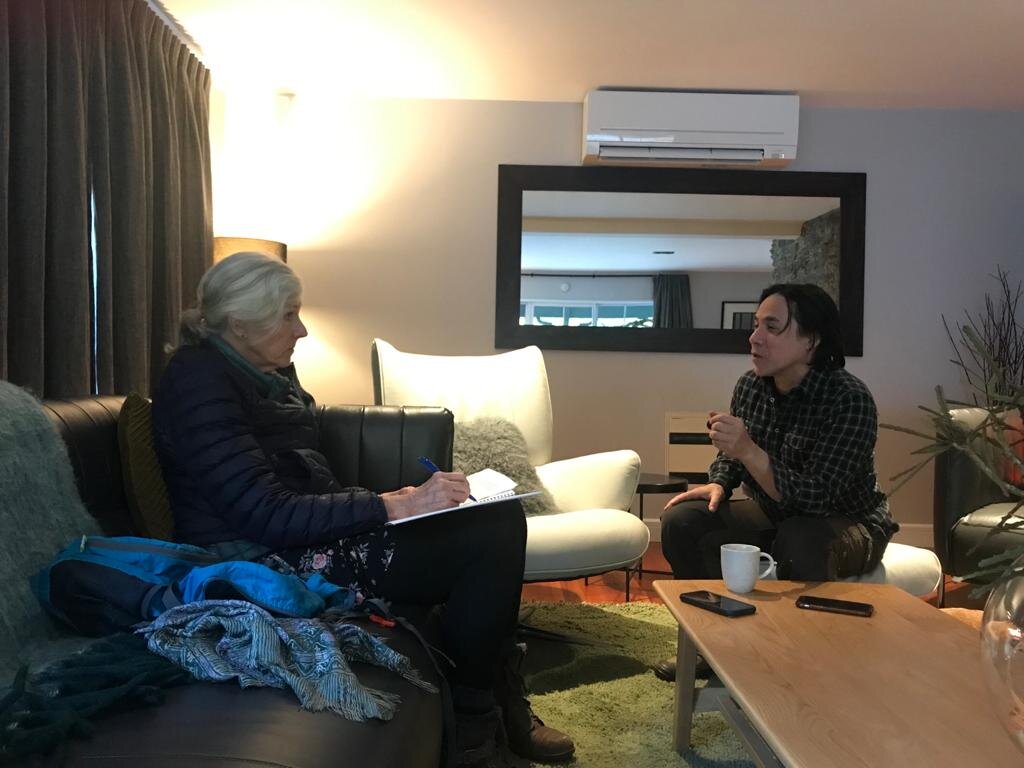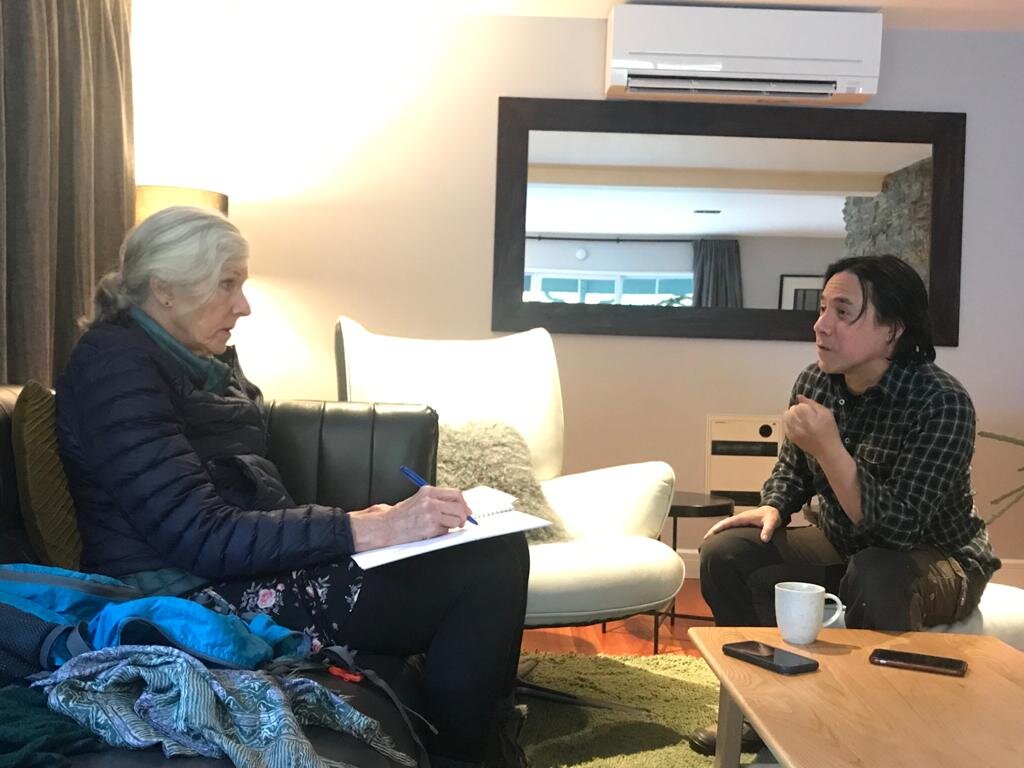Q&A with Lasse holopainen on all things yoga
By Diane Covington-Carter
www.dianecovingtoncarter.com
What can a guest expect to experience with the yoga classes offered here at Maruia River Retreat?
The first thing they can expect is that it is not compulsory. And I find when the “must” disappears, then people are a little more open. And the second thing, I’d like to create an experience where it is about them, it is about their practice.
My goal is, even if you have never practiced yoga before, that you leave here with the fundamentals for a solid life-long practice. And if you have been to yoga before and have a practice, that you go away with a deeper insight of what that practice is.
As a yoga teacher, I am trying to find the moment of ‘yoga’ or union for the student. That is what makes people come back to yoga classes. You remember what it was like the first time you got bitten by the bug. A good yoga teacher can inspire a sense of the profound. You sense a moment of ‘aha!’ in a person and you know they are hooked.
Yoga can change the neuro pathways and connections in the brain. The asanas create moments of elasticity in the brain when you are reforming all these neural connections. At those moments, we are childlike again.
And we can do that with yoga?
Absolutely. Every time I find something new for you to do in the body, some new experience, you are now creating new neural connections. And the way I teach especially, I try to fire the neurons in a certain pattern. Because muscles that fire together are wired together, so that is where the habits come in. That is why I’m very keen on creating the right breathing habits.
The idea of the classes here, whether you are someone who is very experienced or someone who has never done yoga before, I am trying to find a commonality, that can still give everyone that experience of yoga. This is not acrobatics, which can scare people off. We are working towards ease. And when you are in that ease, then the mind itself can still. And in that stillness, that moment of purity, you go, ‘Aha! This is Yoga’. And then you will keep trying to find that again, to feel that again.
This is why I put in the breathing, understanding the chakras and the subtle bodies because this is where I want people to start going. In many ways, the yoga practice is about avoiding disease.
If someone comes for three days and they do yoga every day, what could they expect might happen?
On day one, I give them the basics of muscle activation and a scientific approach to stretching. A combination of western and eastern knowledge. With our yoga studio, Urban Ashram, in the Philippines, we were able to bring in the best teachers in every tradition. I trained with YogaWorks for my first 200 hours and then began studying with teachers from other traditions.
Cristina, my wife has trained 200 hours with YogaWorks and 300 hours with Annie Carpenter.
There is the discipline of the Eastern tradition and the scientific knowledge of the western tradition. When you give a student a kinesthetic experience, even a forward bend of just tilting the pelvis forward with the knees bent, it can be very powerful. And before you know it, they can touch their hands to the ground.
Even after three or four days of yoga, the benefits go forward in your life, they linger. By the third day, I’m instructing very little. On the first day, it may seem slow, but you get all of the instructions. And that way I can start making people move. And I don’t have to worry. People know how to correct themselves. I can look at them and I can see it. And that, for me, is very fulfilling as a teacher.
When you take away all the ‘I have to be able to do all of these poses, I have to do this in order for it to be a practice’, it becomes very freeing. I tell people, ‘just do 15 minutes’.
In the first class, I do an analysis. I have people on chairs so I can see how they move around and whether they have any issues. And yet, even on a chair, I can make it very challenging, even for highly fit individuals. You are using your muscles as resistance bands to the opposite muscles. And it can be hard work, but it doesn’t matter what fitness level you are, you can still work.
I can have someone here for one, two, three days, in small group classes, sometimes even solo classes. I am happy to work with people singly. If I need to, I split up the group into different levels. It is really about just finding out what is right for the group.
And your personal story? You had quite a healing with yoga, right?
I have a highly addictive personality, so I used to smoke a lot of cigarettes. For 25 years, I smoked two packs a day. And I was drinking very heavily. While I thought I was successful and had achieved certain things in life, my private life was like that. I thought I was healthy and strong.
One day, I was on a business trip, I got a slipped disk and I couldn’t get up, my back was out. Three days later, when I could get out of bed, I got on a plane. I had to use a wheelchair, it was so painful. Cristina did some research online and said, ‘okay, let’s go to a yoga class’. She set up a private yoga session and I felt great. So I signed up for classes, all women in them and I thought ‘I can do this’. But I suffered for two years. My ego was crushed.
The first time I had ever heard of yoga was an old book of my father’s in his belongings after he died. That was the first spark. I sometimes believe that yoga is a clue or an Easter egg we leave for each other. Something that is hidden but is a good thing, it is a surprise. An Easter egg so that you can shortcut your karmic life. Any mindfulness practice brings up your karma, it accelerates it. I find that you can moderate it with your practice because it does give you the tools to deal with your karma.
Did you give up the cigarettes?
After two years. Practicing yoga, you begin to look at yourself. I got better, I stopped the cigarettes. Then for my mid-life crisis, I decided to become a longboard downhill skateboarder. I trained and yoga was the key to being able to compete at a high level. When you are going down at 100 km, you need to be very, very sure that you can physically handle it. The control of the body, the proprioception, where is the weight on the board so that you can slide. All of these things you do in a yoga practice. The asana yoga is ultimately all about proprioception. Where are the joints in space?
I put together a team and we ended up going to the 2009 World Championships. I was 40 at the time. Everyone else was 20. I crashed and fractured my neck and began getting bone spurs and the nerves leading out to my arm started getting cut off. So it was slowly cutting off the nerves. There was muscle damage and atrophy across the body and I started stumbling. I went to the US and they said $300,000 will fix it. I ended up having my neck fused in Thailand. And for me, it has been a healing process ever since.
Did you give up skateboarding?
I haven’t. I still skateboard. I have an electric all-terrain skateboard. But I don’t do downhill anymore.
At the Urban Ashram, we had teachers coming in who were also subtle body healers, they were trained in the ‘60s and ’70s, very old school yoga teachers. One of them, an Iyengar teacher, taught me how to use the Feldenkrais method. The movements of the muscles in the subtlest form, allowing the muscles to heal. Imagining the movement already starts sending signals and starts changing things. And just learning how to use the breath and how to direct my own energy into healing. And the asanas retrain your nervous system and then there is the energetic work with the chakras, which promotes nerve healing.
The teachers taught me what they knew about healing and the nerves and I collected it all and put it into something that worked for me. Ray Long, an orthopedic surgeon, is the one who got me back into a headstand after others had told me not to do it. He told me that if you do it correctly, it is actually good for you. It is in the flexion and the extension that healing occurs. People say ‘yoga heals’ and he wanted to know how and why. And he broke that down. A lot of how I teach is influenced by him.
When did you buy this beautiful retreat and lodge along the river?
In 2018, November, we bought Maruia River Retreat. We renovated, modernized the rooms, changed all the lights. October 2019, we opened, and then in March 2020, we closed due to Covid, after only six months. Overall, we are grateful to be in a country that is disciplined enough and reacted well to control the pandemic. But from our side, we had to cancel and give back the money, but gratefully, a lot of people said, ‘keep the money, we’ll come later’. A year and a half later, this couple from Australia, the moment the borders opened, came. It was their first trip to New Zealand, and they chose to come here. They spent four days, and they said ‘this is the perfect timing for us, we’re at a stage where we have to make life decisions, so it is perfect that we are here now’,
That kind of response makes it worthwhile for us because we didn’t know if we would open again. We decided to do a couple of retreats, so we opened in July 2020 and did ‘Eat. Yoga. Love.’ and we sold out both weekends. That encouraged us to start again in September.
We are primarily a Kiwi retreat and maybe some people from Australia. We have retreats and the rest of the time, we operate as a lodge. It is very easy to come up here from Nelson and Christchurch.
Do you find that most guests are open to yoga?
Surprisingly. When we run as a hotel when it is not a retreat weekend, I have had times when everyone comes here and nobody is planning to do the yoga. They do the first yoga class and then they show up for all three days. Then they all eat together, we put all the tables together because it becomes a shared experience. For dinners, even if you want your own space, we serve at the same time, so there’s still a sense you are a part of something that is going on.
For the retreats, people come here and are not sure if they are going to like it. Will there be alcohol? Are they going to be serving meat? (Yes to both questions.) And what do you mean, yoga? And you have a bit of a chat. And what we have found, is that if you have a group that goes to the first day of yoga, they will tell the others to go. And by the end, we have everyone there. Some people will not do it. They just want to hang out. We had one guest that liked to just sit at the fire pit and look out and watch the river go by.
In general, people have been very receptive and our reviews on yoga have been very good. But for me, more importantly, people have told me, ‘I would like to continue, where can I find a teacher? We had one couple, after the first class, by noontime, they had already contacted someone in their hometown to start yoga classes.
I find that especially with couples, what we do here resonates well with them. A lot of wives bring their husbands to the yoga class and the type of yoga I teach tends to resonate well with men. They get it. It is an intellectual engagement and it challenges them. And then they start working quite hard. And I like that, because then I can push them.
The food was wonderful and I noticed you have dietary options?
Thank you. We can make accommodations for all diets. For the retreats, we have had silent retreats, retreats that are all vegetarian, retreats with no alcohol, then we close the bar and we hide the booze. So it depends. We don’t preach moderation, but we try to keep everything in moderation. The food is delicious and we want it to be top quality and chef-level, and at the same time, it is real food.
During the summer, we live off a lot from the garden. And we try to source from our local region.



